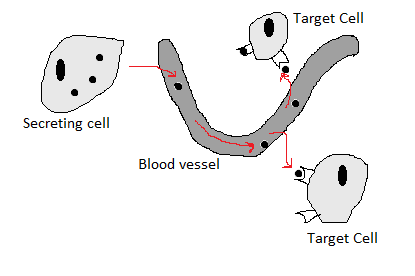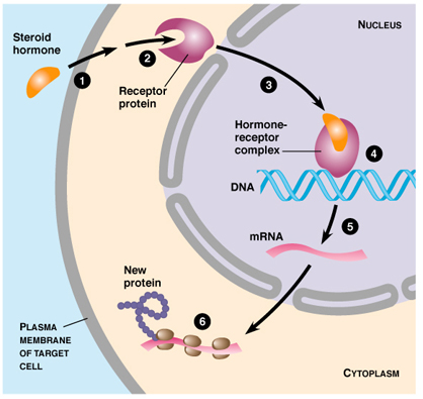Copy of 10.1 Hormones Chemical Regulators.docx
10.1 Hormones: Chemical Regulators
The endocrine system maintains homeostasis and long-term control using chemical signals. The endocrine system works in parallel with the nervous system to control growth and maturation along with homeostasis.
Endocrine glands: ductless gland that secretes hormones directly into the bloodstream or extracellular fluid. These signals are passed through the blood to arrive at a target organ that has the appropriate receptor.

Hormones are characterized by the following:
- Produced by specialized gland
- Secreted directly into the bloodstream
- Effect on body must be elsewhere than where produced
- Only very small amounts necessary
- Act on specific target cells by regulating metabolic rate
(controls activities of specific enzymes)
- Hormones linked to specific target tissue by a specific receptor
(found on membrane of target cells)
Hormones are grouped into 2 classes based on their structure:
- Steroids 2) Protein
Steroids (lipid-soluble) hormones:
- Derived from cholesterol
- Secreted by the gonads, adrenal cortex, and placenta
- Not soluble in water but are soluble in fat which allows it to pass through membrane of a target cell
- Once inside, the hormone attaches onto a protein receptor
- This hormone-receptor complex then enters the nucleus, activating the gene that produces an enzyme that initiates the desired chemical reaction
Sex steroids→ progesterone, testosterone, estradiol
These hormones diffuse from the capillaries into the interstitial and then into the target cells, where they combine with receptor molecules located in the cytoplasm (or nucleus of a cell).

Example: aldosterone is secreted by the adrenal glands when blood pressure falls below normal…the aldosterone travels through cell membranes and attaches to receptors found only in certain cells (kidneys, sweat glands, and colon)…..the receptor acts as a transcription factor for a gene which leads to the synthesis of proteins that increase sodium reabsorption….increase in sodium in the blood causes water to be retained and this increases blood pressure.
Protein (water-soluble) hormones:
- These hormones are non fat-soluble,
- They usually do not enter cells to exert their effect. Instead, they bind to receptors on the surface of the target cell. This combination substance then triggers a specific chain of chemical reactions within the cell…hormone binds to surface receptor and activates it…activated receptor triggers a signal pathway…signal leads to cellular response
- Chains of AAs (ranging in size from a few amino acids to more than 200
- Most hormones are proteins based
- Secreted by the pituitary, parathyroid, heart, stomach, liver, and kidneys

When protein hormones bind to receptor molecules in the cell membrane, this ultimately causes a signal to pass into the cell. That triggered response can do a variety of functions such as activate enzymes, stimulate cellular secretion, or open ion channels.
- Endorphins are an example of this hormone
- present during strenuous exercise/excitement/pain
- produce analgesia and feeling of well-being
- work as “natural pain relievers”
- Epinephrine (adrenaline) is an example of a hormone secreted from the thyroid and the adrenal medulla
- when produced in the body it increases heart rate, contracts blood vessels, and dilates air passages
- participates in the “fight or flight” response of the sympathetic nervous system